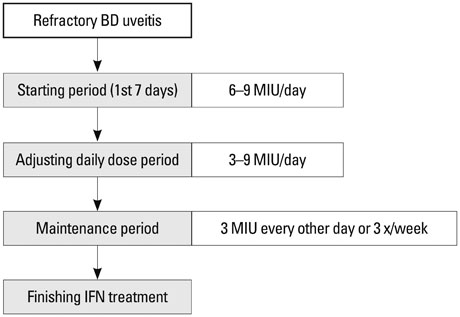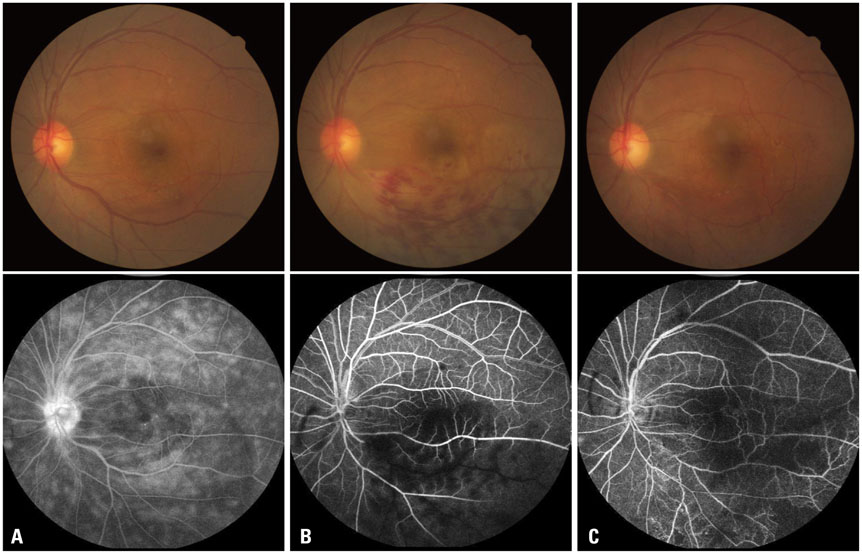Yonsei Med J.
2015 Jul;56(4):1158-1162. 10.3349/ymj.2015.56.4.1158.
Clinical Experience of Interferon Alfa-2a Treatment for Refractory Uveitis in Behcet's Disease
- Affiliations
-
- 1Ozhean Skin Clinic, Seoul, Korea.
- 2Department of Ophthalmology, Ajou University School of Medicine, Suwon, Korea.
- 3Department of Dermatology, Ajou University School of Medicine, Suwon, Korea. esl@ajou.ac.kr
- KMID: 2366362
- DOI: http://doi.org/10.3349/ymj.2015.56.4.1158
Abstract
- Behcet's disease (BD) involves multisystem vasculitis of unknown origin. Ocular manifestations of BD mostly include bilateral panuveitis and retinal vasculitis, which are very challenging to treat. Interferon alfa-2a (IFN) has been recently introduced for treating refractory Behcet uveitis, mainly in Germany and Turkey. Nonetheless, there is so far no consensus about the ideal treatment regimen of IFN for Behcet uveitis. We report our experience of IFN treatment in five Korean BD patients with refractory uveitis. All patients complained of oral ulcers; one patient had a positive pathergy test and 2 showed the presence of HLA-B51. Immunosuppressive agents used prior to IFN treatment included cyclosporine and methotrexate. The IFN treatment was commenced with a dose of 6-9 MIU/day for 7 days, adjusted according to individual ocular manifestations, tapered down to 3 MIU three times in a week, and then discontinued. All patients showed positive response to IFN treatment; 50% of them showed complete response without additional major ocular inflammation during the follow-up period. Other BD symptoms also improved after IFN treatment in most cases. After treatment, the relapse rate and the required dose of oral corticosteroid were decreased in most cases, showing a significant steroid-sparing effect. However, the visual acuity was not improved in most cases due to irreversible macular sequelae. Despite the small sample size of this study, we suggest that, in Korean patients, IFN is an effective treatment modality for BD uveitis as was observed in German and Turkish patients.
Keyword
MeSH Terms
-
Adult
Behcet Syndrome/complications/diagnosis/*drug therapy
Chronic Disease
Cyclosporine/therapeutic use
Female
Humans
Immunosuppressive Agents/administration & dosage
Interferon-alpha/*therapeutic use
Male
Recombinant Proteins/therapeutic use
Recurrence
Remission Induction
Treatment Outcome
Turkey
Uveitis/diagnosis/*drug therapy/etiology
Visual Acuity
Cyclosporine
Immunosuppressive Agents
Interferon-alpha
Recombinant Proteins
Figure
Reference
-
1. Sakane T, Takeno M, Suzuki N, Inaba G. Behçet's disease. N Engl J Med. 1999; 341:1284–1291.
Article2. Bodaghi B, Gendron G, Wechsler B, Terrada C, Cassoux N, Huong du LT, et al. Efficacy of interferon alpha in the treatment of refractory and sight threatening uveitis: a retrospective monocentric study of 45 patients. Br J Ophthalmol. 2007; 91:335–339.
Article3. Na S, Park J, Cho S, Cho S, Bang D, Rho J, et al. Epidemiological and clinical characteristics of Behcet's disease in Korea - using a clinical database for patients' registry. In : 15th International conference on Behcet's disease 2012; Yokohama, Japan.4. Kötter I, Zierhut M, Eckstein AK, Vonthein R, Ness T, Günaydin I, et al. Human recombinant interferon alfa-2a for the treatment of Behçet's disease with sight threatening posterior or panuveitis. Br J Ophthalmol. 2003; 87:423–431.5. Onal S, Kazokoglu H, Koc A, Akman M, Bavbek T, Direskeneli H, et al. Long-term efficacy and safety of low-dose and dose-escalating interferon alfa-2a therapy in refractory Behçet uveitis. Arch Ophthalmol. 2011; 129:288–294.
Article6. Feron EJ, Rothova A, van Hagen PM, Baarsma GS, Suttorp-Schulten MS. Interferon-alpha 2b for refractory ocular Behçet's disease. Lancet. 1994; 343:1428.7. Evereklioglu C. Ocular Behçet disease: current therapeutic approaches. Curr Opin Ophthalmol. 2011; 22:508–516.8. Sobaci G, Erdem U, Durukan AH, Erdurman C, Bayer A, Köksal S, et al. Safety and effectiveness of interferon alpha-2a in treatment of patients with Behçet's uveitis refractory to conventional treatments. Ophthalmology. 2010; 117:1430–1435.
Article9. Treusch M, Vonthein R, Baur M, Günaydin I, Koch S, Stübiger N, et al. Influence of human recombinant interferon-alpha2a (rhIFN-alpha2a) on altered lymphocyte subpopulations and monocytes in Behcet's disease. Rheumatology (Oxford). 2004; 43:1275–1282.
Article10. Zierhut M, Abu El-Asrar AM, Bodaghi B, Tugal-Tutkun I. Therapy of ocular Behçet disease. Ocul Immunol Inflamm. 2014; 22:64–76.
Article
- Full Text Links
- Actions
-
Cited
- CITED
-
- Close
- Share
- Similar articles
-
- Interferon-alpha in the Treatment of Behcet's Disease
- A Case of Improved Refractory Uveitis in Behcet's Disease after Infliximab Therapy
- A Case of Diffuse Neonatal Hemangiomatosis Improved with Prednisolone and Interferon alfa - 2a
- Treatment of chronic hepatitis C: Efficacy of initial treatment of peginterferon alpha-2a versus peginterferon alpha-2b plus ribavirin in naive chronic hepatitis C patients
- A Case of Kasabach-Merritt Syndrome with Disseminated Intravascular Coagulopathy Treated with Interferon alfa-2a



